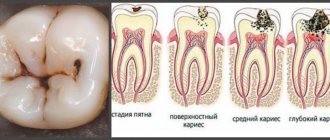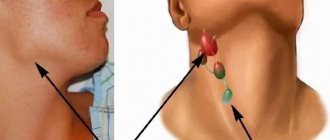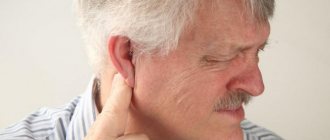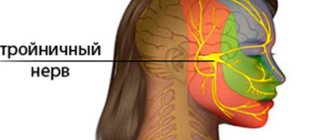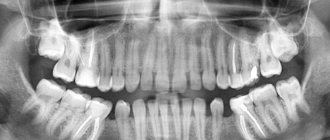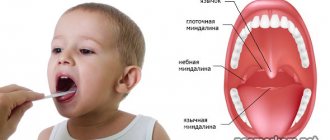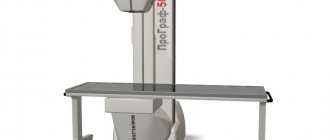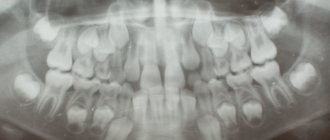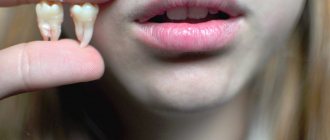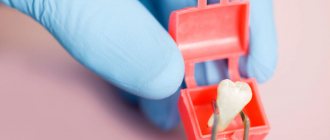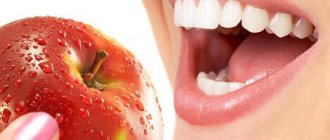The nature of the pain
Physical suffering in the lower part of the face may vary in time, duration and intensity. The pain can be mild or unbearable – preventing you from speaking or consuming food or water. Also, unpleasant sensations can occur periodically or disturb continuously.
How severe the pain is and what its nature is does not indicate the degree of pathology. Even mild pain when pressed may indicate a serious illness. And unbearable long-term suffering, affecting not only the chin but also part of the face, may be a harbinger of neurology that is easily treatable.
What causes pain under the chin?
Pain under the chin can be severe or moderate, transient or constant, radiating or local. The nature of the pain is not particularly important. The main thing is to establish the factors that can cause pain in this area. After all, such manifestations can hide many different pathologies, including quite serious ones. And in order to understand the full extent of the danger of your condition, you need to know the reasons that lead to discomfort.
What influences the occurrence of pain
The face is the only part of the body that is always open. The skin in this place is more exposed to bad environmental influences than anywhere else. Therefore, if a pimple on the chin hurts, no one runs straight to the doctor.
But often unpleasant sensations are associated with the formation of various pathologies. Even acne, which often occurs in adolescence, can be a consequence of blockage of the sebaceous gland or purulent-necrotic inflammation of the follicle. Boils and carbuncles are caused by dangerous bacteria such as Staphylococcus aureus. If you suspect such inflammation, you should immediately consult a doctor.
Rashes and neoplasms of various etiologies
If your chin hurts and the skin on it is inflamed, then most likely this is due to an infection entering the body. The pathological process is usually accompanied by the presence of rashes:
- Pustule is a rash with purulent exudate in the epidermis.
- An abscess is an inflammation of skin tissue, muscles and even organs with serous depressions.
- Cellulitis is an acute purulent inflammation of accumulations of loose fibrous connective and adipose tissue.
- Carbuncles are a pathological process around the sebaceous glands and follicle, which has a tendency to disseminate.
In the initial stages of inflammation, the chin hurts only when pressed. With your fingers you can feel a hard “ball”, which then quickly grows.
Severe pain can occur due to neoplasms, both benign and life-threatening:
- Adamantinoma or ameloblastoma is a benign tumor on the epidermis in which a structure similar to an enamel organ develops. Initially, the disease is asymptomatic. Subsequently, swelling occurs with further involution of the jaw tissue and destruction of the face.
- Osteoid osteoma is a slowly developing pathological formation of bone tissue. The only method of therapy is surgery.
- Osteoblastoclastoma is a mesenchymal tumor originating from bone tissue.
Malignant tumors are life-threatening and require immediate treatment.
Why does ear cartilage hurt? Causes and treatment
The human ear is a complex organ designed to receive and transform sound vibrations. The organ consists of the inner, middle and outer ear. If the integrity or functionality of one of the parts is violated, this leads to malfunctions in the entire auditory system.
The outer ear is the lateral part of the hearing organ, including the pinna and the osteochondral canal, which is the external auditory canal. The basis of the auricular concha is cartilage, consisting of elastin fibers. The difference between cartilage tissue and many others is the absence of nerves and elastic tubular formations inside it through which blood circulates.
https://www..com/watch?v=ytpress
The musculature of the shell is reduced and does not provide its mobility. Motor innervation is carried out by the seventh facial nerve, which also provides communication with the central nervous system of the facial muscles and lacrimal glands. The auriculotemporal and greater auricular nerves supply the concha with afferent nerves.
Causes of pain
There are many factors influencing the appearance of unpleasant sensations on the external part of the hearing organ. It is impossible to immediately answer the question of why ear cartilage hurts. Even a fairly experienced otolaryngologist cannot make an accurate diagnosis without examination results. The reason for this is a large number of similar symptoms related to different pathologies.
Pain can be caused by diseases caused by pathogenic microbes, viruses, injuries of various etiologies, and allergic reactions. In neuralgic diseases, pain in the area of the auricle is one of the symptoms.
If discomfort occurs in young children, it is necessary to contact a pediatrician as soon as possible. If the cause is ear disease, then if not treated promptly, many of them can lead to deafness in childhood.
It happens that the ear cartilage hurts due to a burn to the skin covering it or frostbite. But even if the cause is identified independently, you should still visit a specialist (in this case, a combustiologist), he will determine the degree of tissue damage and prescribe adequate therapy.
Allergy
An allergic reaction manifests itself not only in the form of redness on the skin. It may also be accompanied by pain in the ears and hearing loss.
With such symptoms, you need to reconsider your diet: reduce your intake of protein, red fruits, citrus fruits, change laundry detergents, shampoo, and be sure to get tested for immunoglobulins E.
Ignoring the signs of allergy can lead to inflammation of the mucous membrane of the Eustachian (auditory) tube and the development of tubo-otitis.
Many people, especially representatives of the fair half of humanity, get piercings from a young age.
If, some time after the piercing, the ear cartilage hurts and itches, most likely an allergic reaction has occurred to the antiseptic or the metal from which the jewelry is made.
The earrings need to be removed, the hole should be carefully treated with Miramistin and an antihistamine should be taken. If the condition worsens: redness, increased pain, itching, you should consult a doctor.
Ear injuries
One of the most common causes of ear pain is ear injury. Various injuries: bruises, wounds, insect bites are combined with a violation of the integrity of the elastic ear tissue. Damage can occur due to burns, for example, when using a curling iron or frostbite when ignoring a hat in frosty weather.
In young children who complain of ear pain, the hearing aid should first be examined for the presence of foreign bodies or traces (scratches, bruises) from them.
It happens that a cartilage puncture was made and the ear hurts at the site of the hole. As a rule, this phenomenon is temporary and goes away within a few days. If the situation does not change after some time, you should consult a doctor. He will examine the auditory organ for serious damage to the skin or cartilage tissue.
Otherwise, a hematoma may develop (an accumulation of blood in the thickness of the shell, which develops into necrosis of the cartilage. After examination, the doctor will prescribe antiseptics, ointments for resolving hematomas (Troxevasin, Lyoton), and in case of serious damage and the risk of infection, a course of antibacterial drugs.
Neuralgia
Unpleasant sensations in the ears can occur due to damage to the peripheral nerves. Pain may be a sign of trigeminal, stapedial, vagus neuralgia or inflammation of the ear ganglion.
When the nerves of the occipital zone are damaged, the pain spreads to the ears and temporal zone. Auricular autonomic ganglion disease is manifested by paroxysms of regional pain.
Paroxysm may be accompanied by increased salivation, clicks in the hearing organ and its congestion without loss of sound perception. With neuralgia, the cartilage of the ear hurts when pressed, pulsates in the back of the head, neck and lower jaw.
The treatment is complex. Medication includes B vitamins, anesthetic injections, Apifor tablets (for electrophoresis), Virapin and Apizartron ointments. The effectiveness of therapy is achieved through the use of physiotherapy, acupuncture, laser, and ultraviolet radiation.
Inflammatory and infectious diseases
Physical discomfort in the ear can be a consequence of inflammatory processes. Their list is quite large:
- Perichondritis is an inflammation of the vascularized membrane covering cartilage (perichondrium). The disease is characterized by pain in the ear, swelling, and a general increase in temperature. In severe cases, purulent exudate accumulates between the cartilage and the perichondrome, the skin becomes scarred, and the shell becomes deformed.
- Otomycosis is an infectious disease caused by parasitic mycelium (aspergillus, phycomycetes, candida). Usually only the outer ear is affected. People with reduced immunity and diabetes mellitus suffer from otomycosis. Factors influencing the development of the disease are the entry of dirty water into the ear canal and long-term use of antibacterial ear drops.
- Otitis externa is an inflammatory process in the ear, accompanied by damage to the tissues of the osteochondral canal and concha. In most cases, the disease is infectious. It occurs in mild and severe degrees of otalgia for several days, with a feeling of congestion, itching, and purulent discharge from the ear canal.
Pathogenic microorganisms can enter body tissues due to invasive procedures (piercing). If after a cartilage puncture your ear is swollen and painful, this may indicate an infection. At the first symptoms, you need to contact a therapist, who, after examination, will redirect you to either an otolaryngologist or an infectious disease specialist (depending on the severity of the inflammation).
Pathologies of the temporomandibular joint
If the ear cartilage hurts for a long time and it is difficult to move the lower jaw, most likely these are clinical signs of inflammation of the facial joints.
Arthritis and arthrosis of the temporomandibular joint have a long and persistent course. In addition to pain, characteristic signs of the disease include: facial hyperemia, a feeling of fullness.
Factors influencing the development of TMJ can be of infectious or non-infectious (impacts, fractures) origin.
https://www..com/watch?v=https:accounts.google.comServiceLogin
The presence of arthritis and arthrosis is established using instrumental diagnostics. Treatment is usually done with non-surgical methods.
Water in the ear
It happens that after swimming in the pool, the cartilage of the ear hurts and it is not clear what to do. There is a simple explanation for such cases.
The external auditory canal produces earwax, which serves as a natural lubricant for its walls. Normally, the glands secrete very little of it.
When water gets into the ear, the wax swells and obstruction (clogging) of the ear canal is created, accompanied by decreased hearing, first discomfort, and later pain.
The accumulation of sulfur is called “cerumen plug”. It can be quite dense, so it must be removed by a specialist. It is usually eliminated by washing the passage with antacids. If the ear is not washed, an inflammatory process may begin. Water from reservoirs is especially dangerous.
Causes of discomfort in the lower part of the face
If your chin or under it hurts, you need to find the source that generates these sensations. You can get rid of it only by eliminating the cause, not the symptoms.
1. Inflammation of the lymph nodes.
This organ is a biological filter and serves as a barrier to various infections. You can feel the inflamed node yourself. The organ increases in size during infectious colds, so not only the chin hurts, but also the throat from the inside, especially when swallowing.
The source of inflammation is easily detected. Usually, a small lump under the chin hurts. Inflammation differs from other formations in that it is mobile.
2. Diseases of the thyroid gland.
The organ is located under the larynx. All painful sensations associated with pathological processes of the gland radiate to the chin:
- Hashimoto's thyroiditis. Characterized by severe pain and enlargement in the chin area.
- Riedel's goiter (fibrous thyroiditis). Physical suffering is especially severe when moving the head and swallowing.
- Thyroid cancer is an oncology, a serious and serious disease that requires special attention.
- Trigeminal neuralgia. With pathology, innervation is disrupted and there is pain under the chin when pressing or without pressing in the area of the trigeminal nerve. Treatment is carried out with medications and physiotherapeutic procedures.
Pain in the front of the neck under the chin
The Adam's apple is located under the chin. With awkward movements or strong blows, he gets injured. This is not visible visually, there are no bruises or hematomas. The pain is severe, the victim complains to a traumatologist.
Another reason is infection. Pathogenic microorganisms pass through the lymphatic system, lingering in the nodes. The latter increase in volume, the therapist palpates them under the chin.
When the patient is treated with antiviral and antibacterial agents, the lymph nodes will shrink. Often the increase is caused not by infection, but by allergies.
The immune system does not respond adequately to the invading antigen, resulting in hypersensitivity.
Recommended methods of therapy that alleviate or eliminate pain:
- Conservative. Anti-inflammatory, painkillers, antihistamines, and warming drugs are used. Improve local blood flow with physiotherapy. A magnet, infrared radiation, electrophoresis, and paraffin heating are used. They do a massage, but not in front, but on the back of the neck, to stimulate the muscles and improve blood flow through the vessels.
- Radical. Surgical operations are used to eliminate severe defects and painful conditions. For example, if a benign or malignant tumor is detected in the thyroid gland.
They use complex treatment consisting of several methods. They combine medications and physiotherapy. Every 6 months a general massage is done.
Painful sensations not associated with the presence of pathology
Discomfort is not always associated with impaired organ functionality. Inconvenience can be caused by wearing orthodontic structures (prostheses, braces). The devices deform the gums and change the bite.
Injuries and bruises are one of the common causes of pain in the lower facial region. Unpleasant sensations arise after some time, and their intensity depends on the severity of the damage. Serious injuries may result in a broken jaw. How dangerous the violation of integrity is is determined by the doctor after examination and analysis of x-rays.
Diagnosis and specific treatment
One of the symptoms of a serious pathology may be that your chin hurts. Taking antispasmodics and analgesics will eliminate physical suffering, but will not get rid of the cause. Therefore, if you experience discomfort in the lower part of your face, it is better to consult a doctor. Based on the results of the examination and diagnosis, a course of therapy will be prescribed. Tests to identify the cause of pain:
- X-ray of the skull bones;
- MRI of the brain;
- ENMG is a comprehensive examination that determines the state of the nervous system located beyond the boundaries of the brain and dorsal brain;
- Ultrasound of the head and neck;
- blood and urine tests.
The results may refute previously made assumptions and conclusions. Depending on the diagnosis, you will need the help of the following specialists:
- dermatologist;
- neurologist;
- endocrinologist;
- oncologist;
- surgeon.
The specifics of treatment are determined individually. Depends on the severity and form of the pathology. Serious consequences will be avoided by a timely visit to a specialist and the implementation of absolutely all appointments.
Causes of pain behind the ear
The cause of a serious increase in size of lymph nodes can be a number of different types of diseases. First of all, various inflammatory processes in the ear, such as otitis media or eustachitis.
The lymphatic system itself can be called one of the key parts of the human body that protects it. It identifies specific diseases by eliminating harmful bacteria.
It is in this regard that lymph nodes can be called special filters that absorb and destroy all existing toxins and various pathogens. A significant function of this body system is also the process of blood purification and the subsequent transfer of the most useful substances.
The key reasons why the parotid lymph nodes grow significantly in any person are:
- inflammatory processes of the auditory organ;
- dental diseases;
- diseases of the pharynx;
- severe respiratory diseases;
- malignant lymphoma tumor.
In the case where the lymph nodes grow for any reason mentioned above, after proper therapeutic treatment, everything, as a rule, returns to normal.
Separately, it is necessary to identify cases in which infections affect the occurrence of serious inflammation, which, in addition to the growth of lymph nodes, leads to ear pain that extends to the neck. As a rule, it is caused by various infectious cells.
